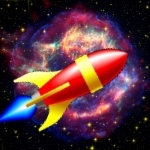
 |
Space Explorer |
Outer space is a fascinating place. With recent advances in technology we are learning new facts and becoming more familiar with the exciting aspects of our solar system.
This activity allows children to become adventurers and explore this alien world. They can watch short movies about our sun, the eight planets, our moon, comets and asteroids, spacecraft and the universe.
On opening the activity there is a picture of various parts of outer space. Children can click on any part of the picture to send their rocket there and play a movie. The subject of the movie is announced as it starts, with a short comment or description.
At the bottom of the movie window are the following buttons:
| Pause button - click to freeze the movie. | |
| Play button - click to unfreeze or restart the movie. | |
| Stops the action and returns to the start of the movie. | |
| Close the movie window to the previous screen. |
To exit, click on the small hand in the lower right corner of the screen.
Outcome 2: Children are connected with and contribute to their world
Outcome 4: Children are involved and confident learners
Outcome 5: Children are effective communicators
Space and technology
Exploration
Program navigation
Using play, pause and stop buttons
Observation skills
Listening skills
Concentration
Independent decision-making
Mouse control - single click
Children will enjoy travelling through space and learning about some of the fascinating subjects shown in these movies. They can pause the movies at any time for a detailed look at the action, continue running the movie or go back to the start.
Here are some common questions and answers about outer space that you may like to consider.
Q. What is outer space?
A. Outer space is defined as the area outside of the planet earth.
Q. How big is outer space?
A. No one knows how big outer space is, as it goes on and on and is impossible to measure.
Q. What is our part of space called?
A. Our solar system is in a galaxy called the Milky Way.
Q. What is our solar system made up of?
A. Our solar system is made up of billions of items that revolve around our sun at its centre. This includes planets, moons of planets, dwarf planets (eg. Pluto), asteroids, comets and space debris.
Q. How many stars are in the Milky Way?
A. Astronomers think that there are between 200 and 400 billion stars in the Milky Way Galaxy, of which our sun is just one.
Q. What are stars?
A. Stars are huge balls of gas that give off tremendous energy, light, and heat. The colour of a star can vary greatly depending on how large and hot they are. They can be red, orange, yellow, white and blue. Blue stars are much hotter than red stars.
Q. What is a planet?
A. To be classed as a planet a space body must follow three rules:
1) It must orbit the sun.
2) It must have enough gravity to pull itself into a round shape.
3) It has to be the only object orbiting the sun in that particular orbit.
Q. Why is Pluto not a planet?
A. Pluto has been discovered to be a huge piece of ice with many other celestial bodies in its orbit. It has been reclassified as a Dwarf Planet.